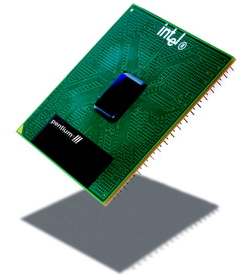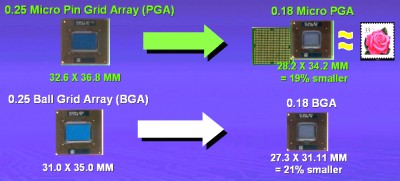Intel's New Weapon: The Coppermine
What Coppermines Will Be Available?
There are a lot of different new Pentium III processors based on the Coppermine-core released today, here's the rather confusing list:
| Coppermine for Desktop | Form Factor | Front Side Bus Clock [MHz] | Multiplier |
|---|---|---|---|
| Pentium III 733 | Slot1 | 133 | x5.5 |
| Pentium III 700 | Slot1 | 100 | x7 |
| Pentium III 667 | Slot1 | 133 | x5 |
| Pentium III 650 | Slot1 | 100 | x6.5 |
| Pentium III 600EB | Slot1 | 133 | x4.5 |
| Pentium III 600E | Slot1 | 100 | x6 |
| Pentium III 533EB | Slot1 | 133 | x4 |
| Pentium III 550E | FC-PGA370 | 100 | x5.5 |
| Pentium III 500E | FC-PGA370 | 100 | x5 |
You can see that Intel is afraid of overclockers. The Coppermines at 500 and 550 MHz share the same multiplier as the Coppermines at 667 and 733 MHz. Thus you could easily overclock the 500 to 667 and the 550 to 733 MHz by simply running them at 133 MHz front side bus clock. To make that a bit tougher Intel released the two low-end Coppermines as PGA-versions only. This won't scare off any real overclocker though, since you can solve this problem by either getting a VIA Apollo Pro 133+-platform with Socket370, as e.g. the Tyan board we used or by using a Socket370 to Slot1 converter card.
The Coppermines for notebooks are released at 500, 450 and 400 MHz, all using 100 MHz front side bus now. Intel added a couple of small new packages for the new mobile coppermine, as you can see in the picture below:
The upper of the two can be removed, since it simply plugs into a socket, the lower of the two has to be soldered onto the notebook's PCB.
Get Tom's Hardware's best news and in-depth reviews, straight to your inbox.
Current page: What Coppermines Will Be Available?
Prev Page Coppermine's New Enhancements, Continued Next Page The Benchmark Results
